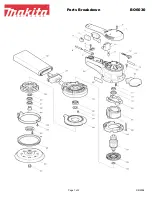
2
■
The sander or polisher is not intended for use in
potentially explosive atmospheres and is not insulated
against contact with electric power.
■
Ensure that there are no electrical cables, gas pipes,
etc., which can cause a hazard if damaged by use of
the tool.
DUST AND FUME HAZARDS
■
Dust and fumes generated when using sanders and
polishers can cause ill health (for example cancer, birth
defects, asthma and/or dermatitis); risk assessment
and implementation of appropriate controls for these
hazards are essential.
■
Risk assessment should include dust created by the
use of the tool and the potential for disturbing existing
dust.
■
Operate and maintain the sander or polisher as
recommended in these instructions, to minimize dust
or fume emissions.
■
Direct the exhaust so as to minimize disturbance of
dust in a dust-filled environment.
■
Where dust or fumes are created, the priority shall be
to control them at the point of emission.
■
All integral features or accessories for the collection,
extraction or suppression of airborne dust or fumes
should be correctly used and maintained in accordance
with the manufacturer's instructions.
■
Select, maintain and replace the consumable/inserted
tool as recommended in the instruction handbook, to
prevent an unnecessary increase in dust or fumes.
■
Use respiratory protection in accordance with
employer's instructions and as required by
occupational health and safety regulations.
NOISE HAZARDS
■
Exposure to high noise levels can cause permanent,
disabling hearing loss and other problems, such as
tinnitus (ringing, buzzing, whistling or humming in the
ears). Therefore, risk assessment and implementation
of appropriate controls for these hazards are essential.
■
Appropriate controls to reduce the risk can include
actions such as damping materials to prevent work
pieces from “ringing”.
■
Use hearing protection in accordance with employer's
instructions and as required by occupational health
and safety regulations.
■
Operate and maintain the sander or polisher as
recommended in the instruction handbook, to prevent
an unnecessary increase in the noise level.
■
Select, maintain and replace the consumable/inserted
tool as recommended in the instruction handbook, to
prevent an unnecessary increase in noise.
■
If the sander or polisher has a silencer, always ensure
it is in place and in good working order when the tool
is being operated.
VIBRATION HAZARDS
The information for use shall draw attention to vibration
hazards that have not been eliminated by design and
construction and remain as residual vibration risks. It shall
enable employers to identify the circumstances in which
the operator is likely to be at risk from vibration exposure.
If the vibration-emission value obtained using ISO 28927-
3 does not adequately represent the vibration emission
in the intended uses (and foreseeable misuses) of the
machine, additional information and/or warnings shall be
supplied to enable the risks arising from vibration to be
assessed and managed.
■
Exposure to vibration can cause disabling damage to
the nerves and blood supply of the hands and arms.
■
Wear warm clothing when working in cold conditions
and keep your hands warm and dry.
■
If you experience numbness, tingling, pain or whitening
of the skin in your fingers or hands, stop using the
sander or polisher, tell your employer and consult a
physician.
■
Operate and maintain the sander or polisher as
recommended in the instruction handbook, to prevent
an unnecessary increase in vibration levels.
■
Hold the tool with a light but safe grip, taking account
of the required hand reaction forces, because the risk
from vibration is generally greater when the grip force
is higher.
ADDITIONAL SAFETY INSTRUCTIONS FOR PNEU-
MATIC POWER TOOLS
■
Air under pressure can cause severe injury.
■
Always shut off air supply, drain hose of air pressure
and disconnect tool from air supply when not in use,
before changing accessories or when making repairs;
■
Never direct air at yourself or anyone else.
■
Whipping hoses can cause severe injury. Always
check for damaged or loose hoses and fittings.
■
Whenever universal twist couplings (claw couplings)
are used, lock pins shall be installed and whip check
safety cables shall be used to safeguard against
possible hose-to-tool or hose-to-hose connection
failure.
■
Do not exceed the maximum air pressure stated on
the tool.
■
Never carry an air tool by the hose.
WARNING
Grinding wheels and cutting off tools shall not be used.




























